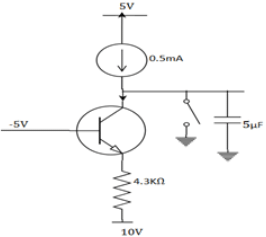Test: Transistor Switching Times - Electrical Engineering (EE) MCQ
10 Questions MCQ Test - Test: Transistor Switching Times
The collector current will not reach the steady state value instantaneously because of_________
For the BJT, β=∞, VBEon=0.7V VCEsat=0.7V. The switch is initially closed. At t=0, it is opened. At which time the BJT leaves the active region?

| 1 Crore+ students have signed up on EduRev. Have you? Download the App |
The technique used to quickly switch off a transistor is by_________
The disadvantage of using the method of reverse biasing base emitter junction is_________
Which of the following circuits helps in the applications of switching times?
Which of the following helps in reducing the switching time of a transistor?
The time taken for a transistor to turn from saturation to cut off is _________
The switching of power with a PNP transistor is called _________
The base emitter voltage in a cut off region is _________
Switching speed of P+ junction depends on _________

















